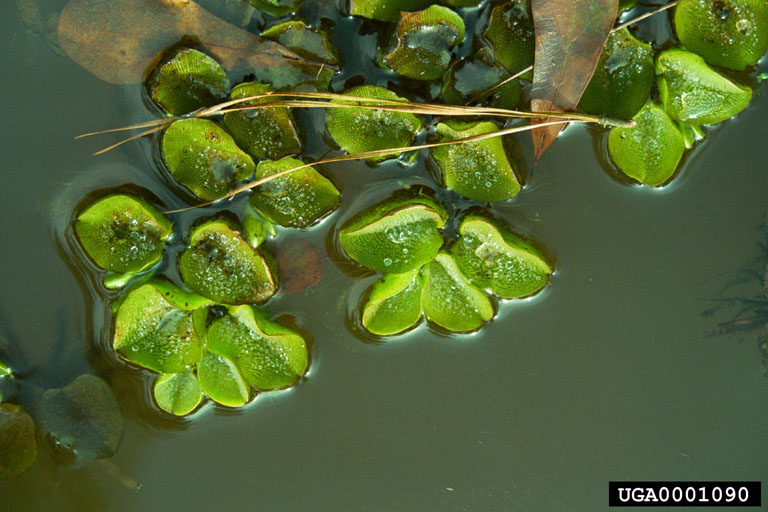Salvinia molesta
Giant Salvinia
Synonym(s): Kariba weed, African pyle, aquarium watermoss, and water velvet
Family: Salviniaceae
Duration and Habit: Annual, Perennial Fern

Photographer: Scott Robinson, Georgia Dept. of Natural Resources
Source: http://extension.entm.purdue.edu/CAPS/pestInfo/giantSalvinia.htm
Description
Salvinia molesta is a free-floating aquatic fern native to Brazil. The two leaves above the water surface are oblong and are about .5 to 1.5 inches in length. Underwater there is one leaf that is modifies modified into small root-like structures. The entire plant is only about 1 to 2 inch in depth.
Ecological Threat: Salvinia molesta grows on the surface of water and normally the vegetation is welcomed by aquatic invertebrates but if colonies of giant salvinia cover the surface of the water, then oxygen depletions and fish kills can occur. These colonies will also eliminate submerged plants by blocking sunlight penetration. Also, large colonies can clog up drains, constrain agriculture by establishing itself in irrigation ditches and can be spread to other areas by boats. Overall, the salvinias have no known direct food value to wildlife and is considered an exotic and highly undesirable species.
Biology & Spread: Salvinia molesta is a small free-floating plant that grows in clusters and develops into dense, floating mats or colonies in quiet water, undisturbed by wave action, like ponds, streams, ditches, marshes and rivers. It prefers nutrient rich waters such as those found in eutrophic water or those polluted by waste water. Salvinia molesta can double in size in 4 to 10 days under good conditions making it an aggressive invader.
History: Giant salvinia has been in the United States since the 1960s and the salvinias have spread from South America to the United States by unwitting human participation. One example was in 1998, Salvinia molesta was being sold in the nursery industry all over Texas and was not identified until the fall. Like most other aquatic plants and animals Salvinia molesta is able to be spread within the states by portions of the plant catching on boats and those boats going to new water sources. Salvinia molesta will continue to spread until
U.S. Habitat: This plant can be found in any still waters in temperate and subtropical climates. It does not usually grow in brackish or salty waters but has been reported in streams with a tidal flow in southeast Texas
Distribution
Native Origin: South America
U.S. Present: AL, AZ, CA, FL, GA, HI, LA, MA, MS, NC, NV, NY, PR, TX, SC and VA
Management
The good news about managing giant salvinia is that control has been demonstrated without the use of toxic chemicals. In tropical parts of Australia, India, Namibia, Papua New Guinea, and Botswana, introductions of the weevil Cyrtobagous salviniae suppressed populations of this aquatic weed. Eradication of big infestations generally requires the use of commercially available herbicides in addition to biological control organisms. An accidental introduction of the weevil occurred in Florida but on Common Salvinia (Salvinia minima). This interaction proved to be beneficial since Florida has less of an issue with Salvinia minima that other states like Texas and Louisiana. Texas Parks and Wildlife has performed an introduction of 112,000 adult weevils in to B.A. Steinhagen Lake, where Salvinia molesta has taken over hundreds of acres. The weevil has successfully destroyed about 150 acres of the invasive plant. A similar effort is now being performed by the U.S. Fish and Wildlife Service at Caddo Lake on the border of Northwest Teas and Northeast Louisiana.
Being a serious threat to native Texas plants, Giant Salvinia is not allowed in the state of Texas. It is illegal to possess or transport this species in Texas. Please report any sightings of this plant.
For images of the Salvinia Weevil click here
Text References
Thomas, P. A., and P. M. Room. 1986. Taxonomy and control of Salvinia molesta. Nature, UK 320.6063: 581-584.
Internet Sources
 Texas Invasive Species Institute
Texas Invasive Species Institute